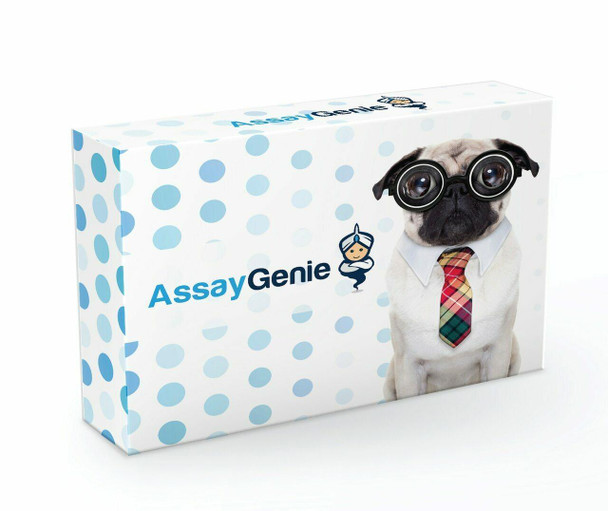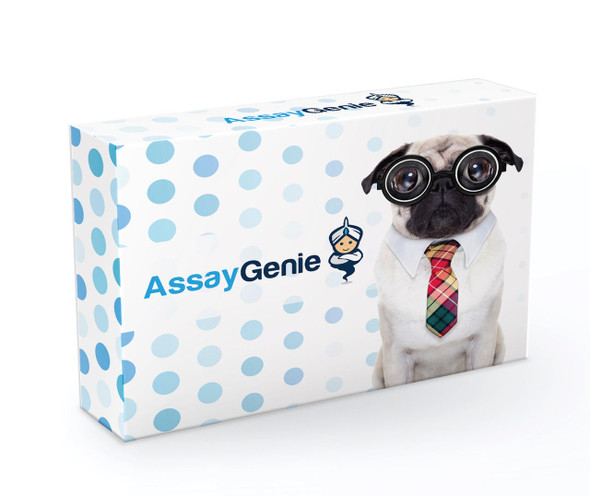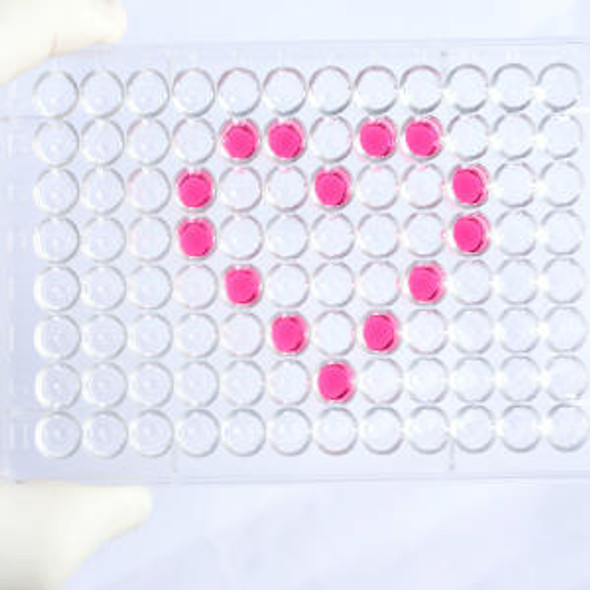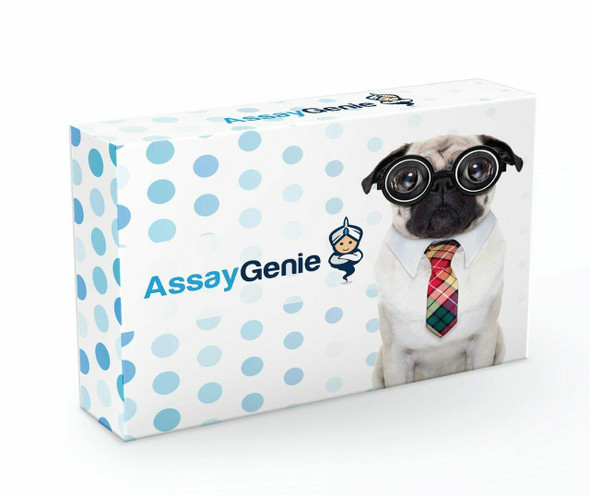Human CMV-IgG (cytomegalovirus-Immunoglobulin G) ELISA Kit (HUFI03440)
- SKU:
- HUFI03440
- Product Type:
- ELISA Kit
- Size:
- 96 Assays
- Sensitivity:
- Qualitative
- Range:
- Qualitative
- ELISA Type:
- Indirect
- Synonyms:
- CMV-IgG
- Reactivity:
- Human
Description
Human CMV-IgG (cytomegalovirus-Immunoglobulin G) ELISA Kit
Key Features
| Save Time | Pre-coated 96 well plate | |
| Quick Start | Kit includes all necessary reagents | |
| Publication Ready | Reproducible and reliable results |
Overview
| Product Name: | Human CMV-IgG (cytomegalovirus-Immunoglobulin G) ELISA Kit |
| Product Code: | HUFI03440 |
| Size: | 96 Assays |
| Alias: | CMV-IgG ELISA Kit |
| Detection Method: | Indirect ELISA - Biotin |
| Application: | This immunoassay kit allows for the in vitro quantitative determination of Human CMV-IgG (cytomegalovirus-Immunoglobulin G) concentrations in serum plasma and other biological fluids. |
| Sensitivity: | < Qualitative |
| Range: | Qualitative |
| Storage: | 4°C for 6 months |
| Note: | For Research Use Only |
Additional Information
| Recovery: | Matrices listed below were spiked with certain level of Human CMV-IgG (cytomegalovirus-Immunoglobulin G) and the recovery rates were calculated by comparing the measured value to the expected amount of Human CMV-IgG (cytomegalovirus-Immunoglobulin G) in samples. Enquire for more information. |
| Linearity: | The linearity of the kit was assayed by testing samples spiked with appropriate concentration of Human CMV-IgG (cytomegalovirus-Immunoglobulin G) and their serial dilutions. The results were demonstrated by the percentage of calculated concentration to the expected. Enquire for more information. |
| CV(%): | Intra-Assay: CV<8% |
Kit Components
| Component | Quantity | Storage |
| ELISA Microplate (Dismountable) | 8x12 strips | 4°C for 6 months |
| Lyophilized Standard | 2 | 4°C/ -20°C |
| Sample/Standard Dlution Buffer | 20ml | 4°C |
| Biotin-labeled Antibody (Concentrated) | 120ul | 4°C (Protection from light) |
| Antibody Dilution Buffer | 10ml | 4°C |
| HRP-Streptavidin Conjugate (SABC) | 120ul | 4°C (Protect from light) |
| SABC Dilution Buffer | 10ml | 4°C |
| TMB Substrate | 10ml | 4°C (Protection from light) |
| Stop Solution | 10ml | 4°C |
| Wash Buffer (25X) | 30ml | 4°C |
| Plate Sealer | 5 | - |
Other materials required:
- Microplate reader with 450 nm wavelength filter
- Multichannel Pipette, Pipette, microcentrifuge tubes and disposable pipette tips
- Incubator
- Deionized or distilled water
- Absorbent paper
- Buffer resevoir
Protocol
*Note: Protocols are specific to each batch/lot. For the correct instructions please follow the protocol included in your kit.
Before adding to the wells, equilibrate the TMB substrate for at least 30 mins at 37°C. When diluting samples and reagents, ensure they are mixed completely and evenly. It is recommended to plot a standard curve for each test.
| Step | Procedure |
| 1. | Set standard, test sample and control (zero) wells on the pre-coated plate respectively, and then, record their positions. It is recommended to measure each standard and sample in duplicate. Wash plate 2 times before adding standard, sample and control (zero) wells! |
| 2. | Aliquot 100µl of standard solutions into the standard wells. |
| 3. | Add 100µl of properly diluted Sample into the sample wells. |
| 4. | Seal the plate with a cover and incubate at 37 °C for 90 mins. |
| 5. | Wash: Repeat the aspiration/wash process for 2 times. |
| 6. | Add 100µl of Biotin-labelled antibody working solution into the bottom of each well (standard, test sample & zero wells) without touching the side walls. |
| 7. | Seal the plate with a cover and incubate at 37°C for 60 mins. |
| 8. | Wash: Remove the cover, and wash plate 3 times with Wash buffer. |
| 9. | HRP-Streptavidin Conjugate (SABC): Add 100µl of SABC Working Solution into each well, cover the plate and incubate at 37°C for 30 minutes |
| 10. | Wash: Remove the cover and wash plate 5 times with Wash Buffer. |
| 11. | TMB Substrate: Add 90 µl of TMB substrate into each well, cover the plate and incubate at 37°C in dark for 10-20 mins. (Note: This incubation time is for reference only, the optimal time should be determined by the end-user.) As soon as a blue colour develops in the first 3-4 wells (with most concentrated standards) and the other wells show no obvious colour, terminate the reaction. |
| 12. | Add 50µl of Stop solution into each well and mix thoroughly. The colour changes into yellow immediately. |
| 13. | Read the O.D. absorbance at 450 nm in a microplate reader immediately after adding the stop solution. |
Sample Type
When carrying out an ELISA assay it is important to prepare your samples in order to achieve the best possible results. Below we have a list of procedures for the preparation of samples for different sample types.
| Sample Type | Protocol |
| Serum | If using serum separator tubes, allow samples to clot for 30 minutes at room temperature. Centrifuge for 10 minutes at 1,000x g. Collect the serum fraction and assay promptly or aliquot and store the samples at -80°C. Avoid multiple freeze-thaw cycles. If serum separator tubes are not being used, allow samples to clot overnight at 2-8°C. Centrifuge for 10 minutes at 1,000x g. Remove serum and assay promptly or aliquot and store the samples at -80°C. Avoid multiple freeze-thaw cycles. |
| Plasma | Collect plasma using EDTA or heparin as an anticoagulant. Centrifuge samples at 4°C for 15 mins at 1000 × g within 30 mins of collection. Collect the plasma fraction and assay promptly or aliquot and store the samples at -80°C. Avoid multiple freeze-thaw cycles. Note: Over haemolysed samples are not suitable for use with this kit. |
| Urine & Cerebrospinal Fluid | Collect the urine (mid-stream) in a sterile container, centrifuge for 20 mins at 2000-3000 rpm. Remove supernatant and assay immediately. If any precipitation is detected, repeat the centrifugation step. A similar protocol can be used for cerebrospinal fluid. |
| Cell culture supernatant | Collect the cell culture media by pipette, followed by centrifugation at 4°C for 20 mins at 1500 rpm. Collect the clear supernatant and assay immediately. |
| Cell lysates | Solubilize cells in lysis buffer and allow to sit on ice for 30 minutes. Centrifuge tubes at 14,000 x g for 5 minutes to remove insoluble material. Aliquot the supernatant into a new tube and discard the remaining whole cell extract. Quantify total protein concentration using a total protein assay. Assay immediately or aliquot and store at ≤ -20 °C. |
| Tissue homogenates | The preparation of tissue homogenates will vary depending upon tissue type. Rinse tissue with 1X PBS to remove excess blood & homogenize in 20ml of 1X PBS (including protease inhibitors) and store overnight at ≤ -20°C. Two freeze-thaw cycles are required to break the cell membranes. To further disrupt the cell membranes you can sonicate the samples. Centrifuge homogenates for 5 mins at 5000xg. Remove the supernatant and assay immediately or aliquot and store at -20°C or -80°C. |
| Tissue lysates | Rinse tissue with PBS, cut into 1-2 mm pieces, and homogenize with a tissue homogenizer in PBS. Add an equal volume of RIPA buffer containing protease inhibitors and lyse tissues at room temperature for 30 minutes with gentle agitation. Centrifuge to remove debris. Quantify total protein concentration using a total protein assay. Assay immediately or aliquot and store at ≤ -20 °C |
| Breast Milk | Collect milk samples and centrifuge at 10,000 x g for 60 min at 4°C. Aliquot the supernatant and assay. For long term use, store samples at -80°C. Minimize freeze/thaw cycles. |
CMV-IgG Background
Cytomegalovirus Immunoglobulin G (CMV-IgG) is a significant serological marker used in the diagnosis and management of cytomegalovirus (CMV) infections. CMV is a prevalent herpesvirus that can infect individuals of all ages, and it remains a public health concern due to its ability to cause severe complications in certain populations. CMV infections are usually asymptomatic or result in mild flu-like symptoms in healthy individuals, but they can be particularly problematic for pregnant women, immunocompromised patients, and newborns. The detection of CMV-IgG in a blood test indicates past exposure to the virus and the production of specific antibodies by the immune system. These antibodies, mainly immunoglobulin G, play a crucial role in providing long-term immunity against CMV.
CMV and Its Transmission
Cytomegalovirus, a member of the herpesvirus family, is commonly transmitted through close contact with infected bodily fluids. Saliva, urine, blood, and breast milk are common sources of CMV transmission. In healthy individuals, CMV infections often go unnoticed or cause mild symptoms, with the immune system effectively controlling the virus. However, in immunocompromised individuals or pregnant women, CMV can lead to severe complications, including organ damage, hearing loss, and developmental issues in newborns.
Immunoglobulin G (IgG) Antibodies
Immunoglobulin G (IgG) is the most abundant class of antibodies in the bloodstream. When the immune system encounters a foreign substance, such as CMV, it produces specific antibodies, including IgG, to target and neutralize the virus. IgG antibodies are highly effective at providing long-term immunity, as they persist in the bloodstream even after the initial infection has been resolved. In the context of CMV, the presence of CMV-IgG in a person's blood indicates a past exposure to the virus, whether it occurred recently or in the distant past.
CMV-IgG FAQs
What is the CMV-IgG ELISA Kit?
The CMV-IgG ELISA Kit is an advanced assay designed to accurately quantify Human Cytomegalovirus-Immunoglobulin G levels in biological samples.
What are the advantages of using the CMV-IgG ELISA Kit?
The CMV-IgG ELISA Kit in several ways. It offers high sensitivity, specificity for Human CMV-IgG, an easy-to-use protocol, quantitative results, compatibility with various samples, and time-efficiency for research screening.
Where can I find more information about the CMV-IgG ELISA Kit?
For more detailed information about the CMV-IgG ELISA Kit, including technical specifications, performance characteristics, and ordering details, please refer to the product brochure or contact our customer support team. We are here to assist you with any inquiries you may have.










